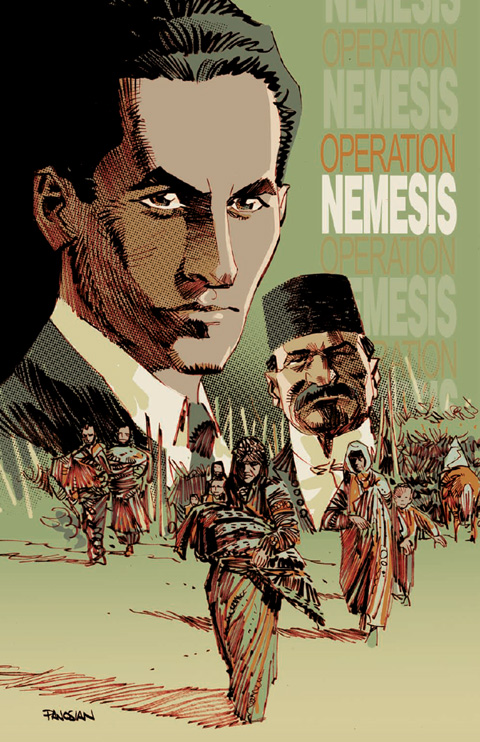Operation Nemesis: A Story of Genocide and Revenge
- (0)
Operation Nemesis: A Story of Genocide and Revenge –

On a day like Halloween when the focus is on supernatural horrors, it is often worth remembering that the worst monsters many times are humans. It seems there is no end to the misery we can inflict on each other, and such a thing has gone on for as long as anyone can remember. The absolute worst crime we can commit upon each other is genocide, which literally translates into “people killing”, the extermination of an entire ethnic group of people. Although it was first coined in 1946 after World War II and the horrors the Nazis inflicted upon the Jews, the terms’ creator Raphael Lemkin had another genocide in mind – the 1915 extermination of the Armenians during the last decades of the Ottoman empire within Turkey. Over one and a half million people were slaughtered by the Turkish army under the command of Talaat Pasha, then head of the Turkish Ottoman Empire, and despite photographic and written proof of the massacre gathered by journalists, soldiers, photographers, and others, not one government official faced any reprimand or trial for this act. There were no trials, and to this day Turkey as a nation insists that the genocide never happened (even going so far as to outlaw mention of it within their borders in 2004). Instead, justice for the atrocity came from the surviving Armenians themselves.
“Operation Nemesis” is a graphic novel published in May by Devil’s Due Entertainment (now “1First Comics“) which tells the amazing true story of genocide survivor Soghomon Tehlirian. A young man from Erzinga, Turkey, his world was turned upside down when his entire village was forced into a death march by the Turkish military and ultimately led into what would become killing fields. Having watched his family members brutally murdered in front of him (and barely surviving death himself), Tehlirian managed to live due to some good fortune and sharp wits. Yet even escaping Turkey was not enough, as he was plagued not only by blackouts and nightmarish dreams, but visions of his murdered mother. Ultimately joining the Armenian Revolutionary Federation, a secretive group which went about targeting the architects of the massacre, Sogohomon committed to taking down Pasha himself (who the group dubbed “number one”). Successfully assassinating Pasha in 1921 (where he was living under an assumed alias in Berlin) was only half the story, as then Soghomon was put on trial in Germany to answer for the crime. Very quickly, his trial would evolve past the fate of one man but towards revealing the depths of the Armenian genocide to Germany and ultimately the world.
This year marks the 100th anniversary of the genocide, and there could be no better time for a graphic novel such as this to emerge to tell such a story in as much detail and visual style as this tome does. Written by Josh Baylock, drawn by Hoyt Silva, colored by Greg & Fake Studio, and produced by David H. Krikorian and Thomas S. Dardarian, it is a difficult yet ultimately important story to behold. Soghomon’s tragedy as well as other testimonials from other Armenian survivors are told and sometimes depicted in grisly detail; enough for the horror to sink in but never such that it becomes perverse. In addition to the story of the genocide, the assassination, and the trial itself, it also is a story about how the powers that be ultimately failed to protect a people from an empire, and would go on to fail to prevent history from repeating itself soon after. The Ottoman Empire in general and Talaat Pasha in particular were under investigation by American ambassador Henry Morgenthau Sr. during World War I, but his hands were unfortunately tied by the sort of red tape and parlor tricks that despots continue to do to this day. Even Adolf Hitler himself took notice of the affairs within Armenia, specifically mentioning the genocide on the dawn of the German invasion of Poland in 1939. It is impossible to know if a better international response to the Armenian genocide could have averted the holocaust, but it remains unfortunate that the event which led to the creation of the term “genocide” would hardly be the last that the world had to suffer.
While based on real events, Baylock and Silva do include some fictional embellishments to allow the story to flow together coherently, and on the whole all of them work and add extra weight to an already heavy story. Each “chapter” of the story is broken up by reprints of real New York Times articles about the events , as well as one disturbing ad for “Armenian slave girls” from the period. It helps bring home the fact that this isn’t just a comic book story, but a graphic depiction of real history involving real people and genuine horrors. Soghomon himself proves to be a fascinating figure to study, as a man who was both clearly traumatized by unspeakable horrors yet determined to become a part of something bigger than himself who found strength and courage within himself that few may ever know.
Those who fail to learn from history are doomed to repeat it. Despite a century of time, the suffering of the Armenians is still a tragedy which many in the mainstream are unaware of and which an entire nation itself continues to deny occurred. “Operation Nemesis” does a great job in teaching uncomfortable truths about the world as well as driving home the fact that no matter what, justice will prevail so long as there are still good people who choose to act in its stead.
examiner.com


















